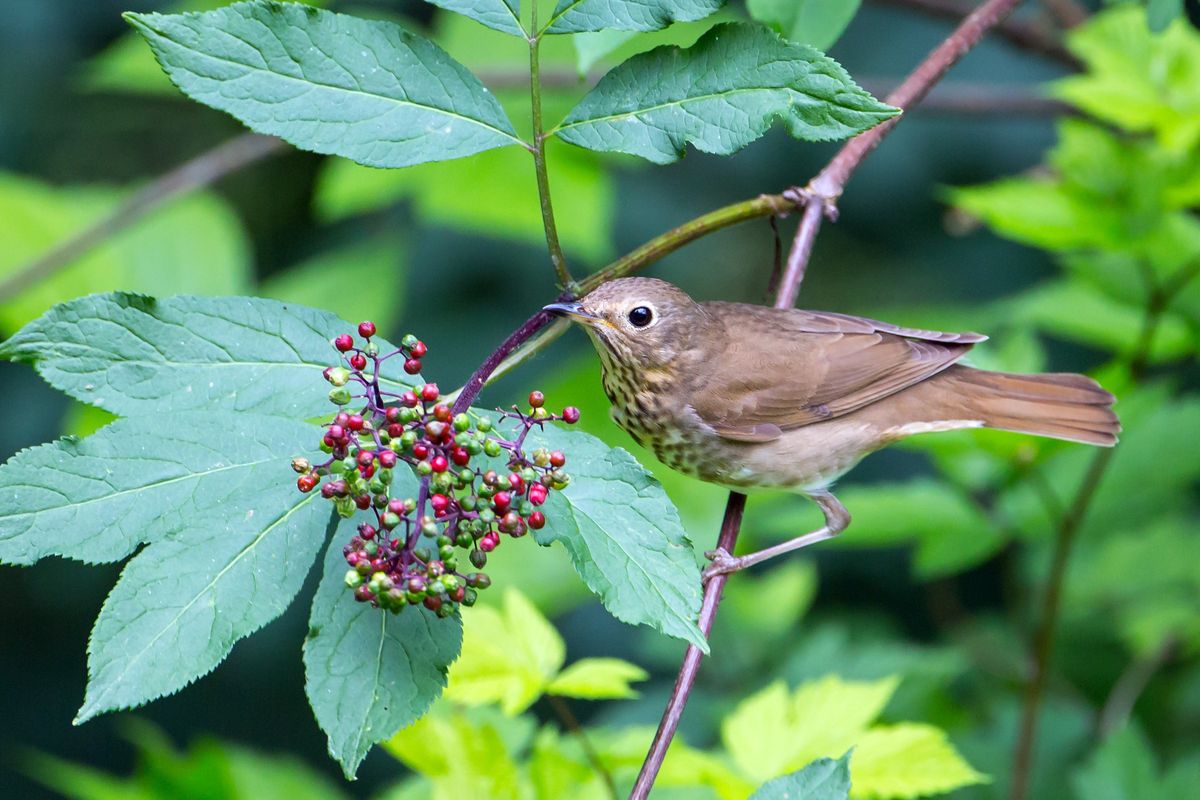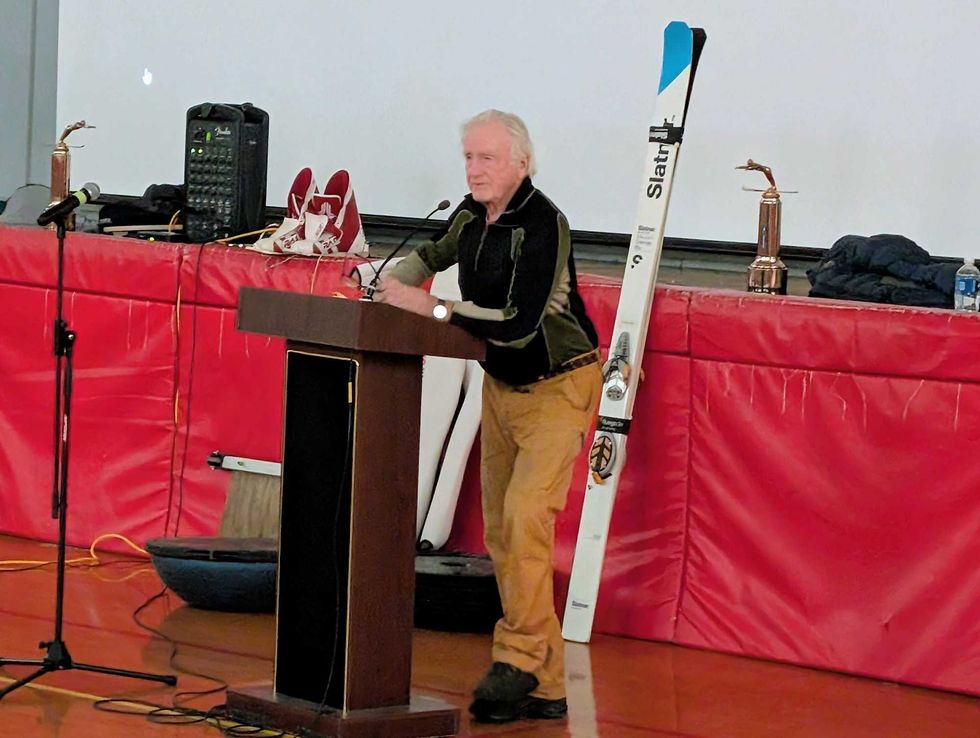
A Swainson's thrush in spring.
Photo by Mick Thompson/Audubon

A Swainson's thrush in spring.
It has not been easy to work outdoors this winter thanks to the rain and melting snow. I am spending more time on social media, which I am not proud to admit, and have found several Facebook Groups – rather Facebook found them for me - that share information on native and invasive plants. The algorithm did good this time. I am rather hooked.
These groups include ‘Native plants of the Northeast’, ‘Native and Invasive Plants of the Eastern US’, ‘Propagating Native Plants’, ‘Invasive Plants ID and Removal in the US and Canada’,
‘Connecticut Native Plants’ and ‘New England Native Plant Seed Share/Trade’. Many within the communities are fierce advocates of native plants. They identify species almost competitively, the way someone might with the New York Times Spelling Bee, and offer suggestions on ridding invasive plants, propagating and planting native substitutes.
Recently, a community member shared a chart that put some data around a serious issue.
Berries of invasive plants do not offer the nutrition required by migrating songbirds. For birds that migrate south for the winter, a lot of fat is needed in their food to sustain them through their journeys. The research study behind this chart comes from a 2013 paper published in the scientific journal Northeastern Naturalist. Even though the study is now 10 years old the findings remain relevant and the issue it informs is more acute than when the study was published.
In addition to migrating birds, those that over-winter in our area require food with a high fat content to nourish them through the winter and into spring when they can rely on caterpillars (and, for the caterpillars to survive we need to plant the native plant they eat.) Sadly, birds in the wild are being malnourished due to the proliferation of non-native and invasive plants and their berries. Birdfeeders can only do so much.
According to the study, Japanese honeysuckle, Lonicera japonica thunbergii berries have less than 1% fat content. Compare this to northern bayberry, Myrica pensylvanica, a native shrub, at 50% fat. Remember tasting the sweet nectar from honeysuckle flowers as a kid? Perhaps the berry is similarly tasty to birds, but don’t eat a berry to find out; although the flowers are fine for human consumption, the berries are toxic to us. Japanese honeysuckle is basically junk food for birds.
The avian candy store includes berries from multiflora rose and buckthorn, with less than 1% fat, and autumn olive and oriental bittersweet at less than 3% fat. Compare with the native plants that co-evolved with local birdlife over millenia: gray dogwood has 35% fat, virginia creeper 34%, arrowwood viburnum and spicebush at 48%. These plants have been largely replaced in our backyards, fields and woodlands with non-natives and invasives, adding to the decline of our bird life.
When a bird ingests a berry it also ingests the hard seed or seeds inside the berry. The bird’s digestive system removes the outer part of the seed and excretes it coated in poop fertilizer, greatly increasing the seed’s chances for germination. This helps to explain the rapid spread of invasive species.
Some of the berries of invasive plants have healthful benefits, providing a few useful nutrients for the birds, and even for humans. Invasive Barberry, Berberis Thunbergii, is a relative of the Barberry, Berberis vulgaris, that is used in Persian cooking. Both types of plants have sour-tasting berries that contain berberine, an antioxidant phytonutrient that has been shown to lower cholesterol and help control blood sugar in humans.
Autumn olive, Elaegnus umbellate, which comes to us from Asia, is a shrub or small tree that can produce as much as 30 pounds of fruit from a single mature specimen. The fruit contains many more times the lycopene levels than our main food source of this carotenoid — tomatoes.
Lycopene has been shown to inhibit certain cancers and protects against diabetes among other benefits of its anti-oxidant rich pulp. Harvesting the prolific number of berries from the autumn olive will help to reduce seed dispersal by birds so, if you decide not to remove the plant it is a good idea to collect as many berries as possible when they are ripe. There are many recipes for autumn olive condiments and dishes to be found online.
The berries of the Amelachier genus are being touted as a superfood in Canada, where the tree is called saskatoon (here we know it as shadblow or serviceberry). According to Web MD and a few other sources I have checked, the berries have plenty of vitamins and minerals as well as the kind of flavonoids that can help prevent blockages in our blood vessels and can protect our heart and liver. They are ripe when purple; not red, or they will be too sour.
There’s only so far a bird feeder will go to solving this life and death issue for the birds in our area; still, it can’t hurt. Planting more native shrubs that produce fat-containing berries is the only long-term solution to the winter nutrition issue. A health food pantry to replace the existing sweet shops in our backyards.
Dee Salomon “ungardens” in Litchfield County.
Students of Salisbury Central School watch ski jumpers soar during an assembly with Salisbury Winter Sports Association Wednesday, Dec. 17.
SALISBURY — Representatives of Salisbury Winter Sports Association gave a presentation at Salisbury Central School Wednesday, Dec. 17.
Former U.S. Olympic coach Larry Stone explained the fundamentals of the unique sport of ski jumping and its long history in Salisbury, where he learned to jump.
“When I was growing up here there were actually eight ski jumps just in this town in addition to the three down at Satre Hill,” he said. He noted that this winter will be the 100th year of Jumpfest at Satre Hill, named for the Satre brothers who moved from Norway in the 1920s. “They brought their sport with them and the first ski jump was actually when one of the Satres skied off of a barn roof in the center of Salisbury to show people how to do it.”
Mentioning the upcoming Winter Olympics in Cortina/Milan, Italy, Stone spoke of legendary Salisbury ski jumper Roy Sherwood who competed at Cortina in the 1956 Olympics.

Students at SCS saw videos of ski jumpers training and competing. Stone invited up students who had jumped at Satre Hill and 14 stepped forward.
One student was Aerin Sheil, who was asked what it feels like to jump: “It kind of feels like you’re flying. It’s a really good feeling.”
Gus Tripler, another student, said, “It’s like you’re suspended in the air and can see everything.”
He said his record distance of 18 meters was set in Vermont.
The student remarks gave way to closing comments that emphasized the school’s partnership with the Salisbury Winter Sports Association.
“Our partnership with SWSA is one of the most incredible things about Salisbury Central School,” Principal John Conklin said as he closed the assembly. He encouraged the students to attend Jumpfest Feb. 6 to 8.

The Community Closet at HVRHS is open for students to take clothes for any reason during the school day.
What started with one unexpected donation of clothes has grown into a quietly impactful resource for all students at HVRHS: the Community Closet. Now located in a spacious area above the cafeteria, the closet offers free clothing to any student for any reason.
The idea began a few years ago when a community member reached out to the former superintendent wondering if anyone at the school could benefit from used clothing that would otherwise go to waste. The superintendent then got in contact with Rachel Novak, the school social worker. “Once I had all those bags of clothes in my room, I was like, ‘I should put this in a space,’” Novak said. Her simple idea eventually became a full-sized closet accessible to all students.
From the beginning, Novak envisioned the closet as an inclusive space. “It’s open to anybody, it’s not just based on economic needs,” she said. Sustainability also plays a role. “Thinking about the environment, some students like to thrift and just get clothes that way,” Novak said.
After the initial donation, contributions continued to grow. “I reached out to our staff members and faculty,” Novak said. The most consistent donations come from the faculty at HVRHS and a few community members who learned about the closet. Finding teenage-appropriate clothes has been a challenge. “I get a lot of donations that are nice, but I don’t think teenagers would want to wear them,” Novak said.
Another ongoing obstacle has been awareness. Many students don’t know the closet exists at all. “That’s been the hard part,” Novak said. “Getting it out to the wider community of the school.” Novak is looking for students and staff to spread the word. “It helps because our school nurse knows and other faculty members,” she said. “When they know a student needs something, they just bring them up.”
Looking ahead, she hopes to promote the space more actively. “When we come back from this break, I do plan to … get fliers and all that up and going,” Novak said. There may even be an upcoming expansion — she has discussed the possibility of turning part of the area into a food pantry. “That would be more of a need-based system for students,” she said. “But right now, promoting it is where I’m at.”
The Community Closet is well-stocked currently. “Just because of the amount of clothes I have, I’m not accepting any more donations until I clear some stuff out,” Novak said. She is still willing to make room for more fashionable, teen-friendly items donated by students. “That way I’ll have more teenager approved clothes.”
Above all, she wants students to know that no one is limited to using the space. “Sometimes there’s a stigma around it … like, ‘I don’t need help. I don’t want to take away from anybody else that may need it,’” Novak said. Due to the amount of clothes, students should feel welcome to use the closet for any reason. Some students even grab items last minute for sports and activities. “It’s important for kids to know it’s for everyone.”
Whether a student wants to thrift clothes sustainably, forgot to pack clothes for an after-school practice, or is in need of a new outfit, the Community Closet is a resource for all.
Sophomore Eliana Lang enjoys her Housy Shack cookie.
Now in its second year, the Housy Shack is a hit among students. The special education department-run store that sells warm cookies, drinks and other snacks to students and teachers draws people to a room in the back hallway every time it’s open.
The smell of warm cookies welcomes visitors to the store with snacks, drinks and even Housy merchandise for sale. The cookies are definitely the favorite, sometimes lines go out the door to get one before they sell out.
The cookies are so popular that the store had to increase prices from 50 cents to a dollar and implement a four cookie per person maximum. The Shack sells about 40-100 cookies per day and has about 20-60 HVRHS customers visiting per day.
Julie Browning and Heather Strid, two of the HVRHS faculty members that help run the Shack, said their goal was to create real-world job experiences as well as real-world shopping experiences for students at HVRHS. “Learning the skills to work in the world can be taught in a classroom, but the lessons are more meaningful and valuable when they are applied in real work situations, which is what we create through the school store,” Browning said.
The original purpose for the store seems to be working, as several students are learning important skills. Students said the store taught them skills like counting money, checking inventory and cleanliness along with social skills and customer service that could help in the professional world after high school.

As the store quickly became a hit, organizers were faced with the challenge of finding funding. “When we started planning to start the school store two years ago we needed money to buy equipment, supplies and food to start it up but were not sure how to get it,” Browning said. “Mrs. Strid came up with the idea of applying for a grant from the 21st Century Fund to help us get started and they were so generous.” That grant has been crucial to the success and growth of the school store.
Not only does the Housy Shack benefit the special education department, students said it fosters a sense of community throughout the school. “School store cookies are my favorite thing ever. They brighten up my day,” said Eliana Lang, a sophomore at HVRHS. Dayana, one of the student staffers at the Housy Shack, said her favorite part of working in the school store is when students come in to make purchases. She enjoys talking to them and ringing up their orders on the cash register. The Housy Shack brings people together and offers the opportunity for students to connect with each other.
As the school year continues, the members of the school store look forward to expanding their inventory by creating and selling a variety of Housy merchandise — t-shirts, sweatshirts, water bottles, and more. “I have had several students put in requests for certain hats, key chains, etc. … so there will be more of that to come,” Browning said. Last school year, profits were all invested back into the school store. “This year we are hoping to make more of a profit and will look to use the money that we make for field trips, outings as well as opportunities to donate and give back to the community,” Browning said. They also would like to use the school store to fundraise for other causes. “Right now we are collecting donations for The Little Guild Animal Shelter, so if anyone has pet supplies they would like to donate please drop them off in exchange for a cookie,” Browning said.